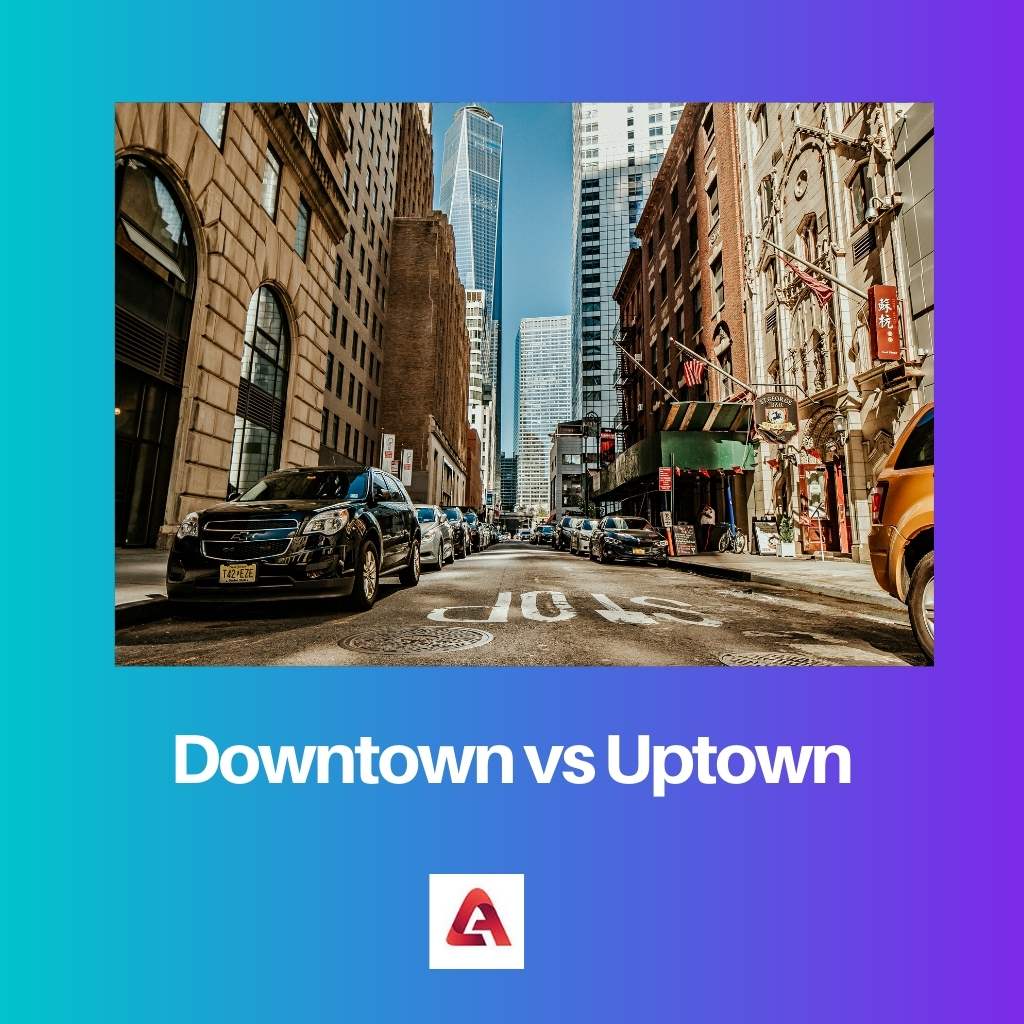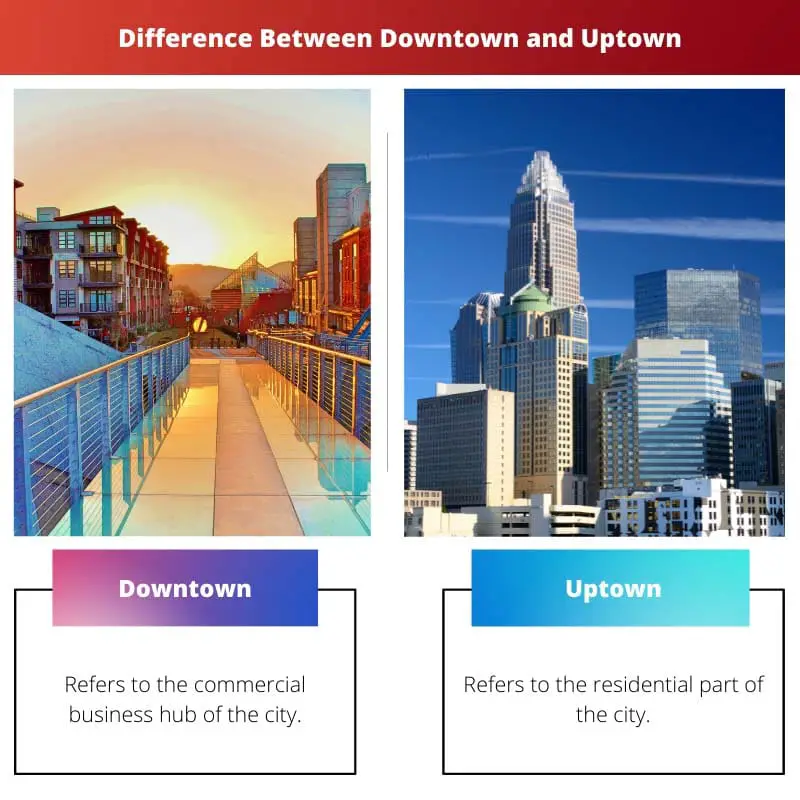“Downtown” refers to the central business district of a city, characterized by bustling streets, towering skyscrapers, and a concentration of commerce, entertainment, and cultural attractions. In contrast, “Uptown” denotes a more affluent and residential area situated farther from the city center, featuring upscale amenities, spacious homes, and a quieter atmosphere, while still offering access to amenities and services.
Key Takeaways
- Downtown refers to the central business district of a city, while uptown refers to the residential areas away from the central business district.
- Downtown is characterized by high-rise buildings, offices, and commercial establishments, while uptown has lower buildings, residential areas, and parks.
- Downtown is more crowded and has a higher cost of living than uptown.
Downtown vs Uptown
The difference between downtown and uptown is that downtown refers to the commercial business hub of the city. In contrast, uptown is used to refer to the residential part of the town.
Downtown has a busy life, whereas uptown life is peaceful and quiet.

The name downtown was first given to Manhattan, which settled at the southern end of New York. With time, this place became the principal commercial business settlement.
And for this reason, downtown was later referred to as the area, which is the city’s central business hub. It was later also used to refer to the directions.
Uptown refers to the residential part of the city, basically the suburbs. This place is quiet and peaceful. It has a lot of significant empty land, so it is suitable for people who want to live in big houses.
Uptown was also used to refer to the north direction.
Comparison Table
| Feature | Downtown | Uptown |
|---|---|---|
| Location | Considered the central business district (CBD) | Can be located various places relative to downtown – sometimes directly north, sometimes in a more suburban area |
| Primary Function | Business and commerce | More of a mixed-use area with residential, commercial, and entertainment options |
| Atmosphere | Busy and bustling during the day, quieter at night (except for entertainment areas) | Can be lively during the day and night, with a focus on restaurants, bars, and nightlife |
| Housing | Mostly high-rise office buildings, with some luxury apartments or condos | More diverse housing options, including high-rise apartments, condos, townhomes, and even single-family homes (depending on the city) |
| Transportation | Often well-served by public transportation | Public transportation options may be more limited, with a greater reliance on cars |
| Amenities | Limited green space, but many restaurants, shops, and cultural attractions | May have more green space, parks, and family-friendly amenities alongside restaurants and bars |
| Rent/Property Values | Generally more expensive due to high demand | Can vary depending on the specific location and type of housing, but may be slightly less expensive than downtown |
What is Downtown?
Downtown, referred to as the central business district (CBD), is the core area of a city where commercial, financial, and governmental activities are concentrated. It serves as the economic and cultural hub, pulsating with energy and offering a plethora of opportunities for work, leisure, and exploration.
Characteristics of Downtown
- Bustling Urban Environment: Downtown areas are characterized by their vibrant atmosphere, with bustling streets teeming with pedestrians and vehicles. The skyline is dominated by towering skyscrapers, symbolizing the city’s economic prowess and modernity.
- Diverse Mix of Businesses: From corporate headquarters to small businesses, downtown districts host a diverse array of enterprises. This includes banks, law firms, tech startups, retail stores, restaurants, theaters, and art galleries, creating a dynamic ecosystem that caters to various needs and interests.
- Cultural and Entertainment Hub: Downtown is not only a center for commerce but also a focal point for cultural and entertainment activities. It houses museums, theaters, concert halls, and sports arenas, attracting residents and tourists alike with a rich tapestry of artistic expression and recreational opportunities.
- Transportation Hub: Due to its central location, downtown areas serve as transportation hubs, facilitating easy access via public transit systems such as subways, buses, and trains. Major highways and airports may also converge in or near downtown, enhancing connectivity with other parts of the city and beyond.
- Mixed-Use Development: In recent years, urban planners have embraced mixed-use development in downtown areas, integrating residential, commercial, and recreational spaces within the same vicinity. This trend fosters a sense of community, encourages pedestrian activity, and promotes sustainability by reducing reliance on automobiles.
- Historical Significance: Many downtown districts boast a rich history, with iconic landmarks and architectural gems that reflect the city’s heritage and evolution over time. Preservation efforts aim to conserve these cultural treasures while accommodating modern development and revitalization initiatives.

What is Uptown?
Uptown refers to the residential and commercial district situated in a city’s higher elevation or farther away from its downtown area. Unlike downtown, which serves as the central business district, uptown neighborhoods are characterized by their residential focus, upscale amenities, and a more relaxed atmosphere.
Characteristics of Uptown
- Residential Focus: Uptown neighborhoods are primarily residential, featuring a mix of single-family homes, townhouses, condominiums, and apartment buildings. These areas attract affluent residents seeking spacious accommodations and a quieter lifestyle away from the hustle and bustle of downtown.
- Upscale Amenities: Uptown districts are known for their upscale amenities and services catering to the needs and preferences of their residents. This may include boutique shops, high-end restaurants, gourmet markets, luxury spas, and exclusive fitness centers, offering a premium lifestyle experience.
- Green Spaces and Parks: Uptown neighborhoods prioritize green spaces and parks, providing residents with opportunities for outdoor recreation, relaxation, and community gatherings. Well-maintained parks, tree-lined streets, and landscaped gardens contribute to the area’s aesthetic appeal and quality of life.
- Cultural and Entertainment Offerings: While not as densely packed as downtown, uptown areas still offer cultural and entertainment amenities, albeit on a smaller scale. This may include art galleries, theaters, performance venues, and upscale dining establishments, providing residents with access to cultural enrichment and leisure activities.
- Schools and Educational Institutions: Uptown neighborhoods frequently boast reputable schools and educational institutions, attracting families seeking quality education for their children. Proximity to prestigious schools and universities adds to the desirability of these areas for affluent residents.
- Accessibility and Connectivity: Despite being situated farther from downtown, uptown neighborhoods enjoy good accessibility and connectivity. Well-planned transportation infrastructure, including public transit options and major roadways, ensures convenient access to downtown and other parts of the city.
- Low Crime Rates and Sense of Security: Uptown neighborhoods have lower crime rates compared to downtown areas, contributing to a greater sense of safety and security among residents. This factor, combined with well-maintained streets and a strong sense of community, enhances the overall quality of life in these areas.

Main Differences Between Downtown and Uptown
- Location:
- Downtown is situated in the central business district of a city, closer to its core.
- Uptown is located in areas of higher elevation or farther away from downtown, emphasizing residential neighborhoods.
- Focus and Atmosphere:
- Downtown is primarily focused on commerce, culture, and entertainment, with a bustling atmosphere characterized by skyscrapers, businesses, and cultural institutions.
- Uptown places more emphasis on residential living, offering upscale amenities, green spaces, and a quieter atmosphere conducive to family life and leisure.
- Characteristics:
- Downtown features a concentration of businesses, restaurants, shops, cultural attractions, and high-density development.
- Uptown is characterized by upscale residences, boutique shops, parks, schools, and a more relaxed pace of life.
- Demographics:
- Downtown tends to attract a mix of professionals, tourists, and young urban dwellers seeking vibrant city life.
- Uptown attracts affluent families, empty nesters, and individuals desiring a more serene and upscale residential environment.
- Accessibility:
- Downtown areas have excellent accessibility, with well-developed transportation infrastructure and proximity to major highways and public transit hubs.
- Uptown neighborhoods may have slightly less accessibility but still offer convenient access to downtown and other parts of the city via public transit and major roadways.






